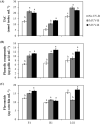UV-B Irradiation Effect on Microalgae Performance in the Remediation of Effluent Derived from the Cigarette Butt Cleaning Process
- PMID: 36145757
- PMCID: PMC9504614
- DOI: 10.3390/plants11182356
UV-B Irradiation Effect on Microalgae Performance in the Remediation of Effluent Derived from the Cigarette Butt Cleaning Process
Abstract
In this study, the potential of ultraviolet B (UV-B) radiation to alleviate the effects of pollutants in cigarette butt wastewater (CBW) was investigated using different Chlorella sorokiniana strains (F4, R1 and LG1). Microalgae were treated with UV-B (1.7 W m-2) for 3 days prior to their exposure to CBW and then incubated for 4 days in the absence or presence of UV-B. UV-B-untreated microalgae were used as the control. Comparative physiological responses, including photosynthetic pigments and non-enzymatic antioxidants, as well as nicotine and nicotyrine removal, were evaluated in 7-day cultures. UV-B treatments did not negatively impact algal chlorophyll or carotenoid production. UV-B acclimation was strain-dependent, correlating with native environment adaptations and genetic constitutions. UV-B as a pretreatment had long-term positive effects on non-enzymatic antioxidant capacity. However, LG1 needed more time to readjust the pro-oxidant/antioxidant balance, as it was the most UV-B-sensitive. Phenolic compounds played an important role in the antioxidant system response to UV-B, while flavonoids did not contribute to the total antioxidant capacity. Although cross-resistance between UV-B and CBW was observed in F4 and R1, only R1 showed nicotine/nicotyrine catabolism induction due to UV-B. Overall, the results suggest that UV-B activates defense pathways associated with resistance or tolerance to nicotine and nicotyrine.
Keywords: Chlorella sorokiniana; flavonoids; nicotine; nicotyrine; non-enzymatic antioxidants; phenolic compounds; photosynthetic pigments; ultraviolet light.
Conflict of interest statement
The authors declare no conflict of interest. The funders had no role in the design of the study; in the collection, analyses or interpretation of data; in the writing of the manuscript; or in the decision to publish the results.
Figures





Similar articles
-
Exploring the Physiological Multiplicity of Native Microalgae from the Ecuadorian Highland, Italian Lowland and Indoor Locations in Response to UV-B.Int J Mol Sci. 2023 Jan 10;24(2):1346. doi: 10.3390/ijms24021346. Int J Mol Sci. 2023. PMID: 36674853 Free PMC article.
-
Remediation Capacity of Different Microalgae in Effluents Derived from the Cigarette Butt Cleaning Process.Plants (Basel). 2022 Jul 3;11(13):1770. doi: 10.3390/plants11131770. Plants (Basel). 2022. PMID: 35807722 Free PMC article.
-
[Effects of Enhanced Ultraviolet B Irradiation on Photosynthetic and Antioxidant System of Sorghum Seedlings].Guang Pu Xue Yu Guang Pu Fen Xi. 2016 May;36(5):1389-95. Guang Pu Xue Yu Guang Pu Fen Xi. 2016. PMID: 30001012 Chinese.
-
The role of UV-B radiation in aquatic and terrestrial ecosystems--an experimental and functional analysis of the evolution of UV-absorbing compounds.J Photochem Photobiol B. 2002 Feb;66(1):2-12. doi: 10.1016/s1011-1344(01)00269-x. J Photochem Photobiol B. 2002. PMID: 11849977
-
Separate and combined responses to water deficit and UV-B radiation.Plant Sci. 2013 Dec;213:98-105. doi: 10.1016/j.plantsci.2013.09.003. Epub 2013 Sep 7. Plant Sci. 2013. PMID: 24157212 Review.
Cited by
-
The Multifaceted Responses of Plants to Visible and Ultraviolet Radiation.Plants (Basel). 2024 Feb 20;13(5):572. doi: 10.3390/plants13050572. Plants (Basel). 2024. PMID: 38475419 Free PMC article.
-
Integrated Physiologic and Proteomic Analyses Reveal the Molecular Mechanism of Navicula sp. in Response to Ultraviolet Irradiation Stress.Int J Mol Sci. 2024 Feb 27;25(5):2747. doi: 10.3390/ijms25052747. Int J Mol Sci. 2024. PMID: 38473996 Free PMC article.
-
Exploring the Physiological Multiplicity of Native Microalgae from the Ecuadorian Highland, Italian Lowland and Indoor Locations in Response to UV-B.Int J Mol Sci. 2023 Jan 10;24(2):1346. doi: 10.3390/ijms24021346. Int J Mol Sci. 2023. PMID: 36674853 Free PMC article.
References
-
- World Health Organization . Tobacco and Its Environmental Impact: An Overview. WHO; Geneva, Switzerland: 2017.
-
- Selmar D., Radwan A., Abdalla N., Taha H., Wittke C., El-Henawy A., Alshaal T., Amer M., Kleinwächter M., Nowak M., et al. Uptake of Nicotine from Discarded Cigarette Butts—A so Far Unconsidered Path of Contamination of Plant-Derived Commodities. Environ. Pollut. 2018;238:972–976. doi: 10.1016/j.envpol.2018.01.113. - DOI - PubMed
Grants and funding
LinkOut - more resources
Full Text Sources

